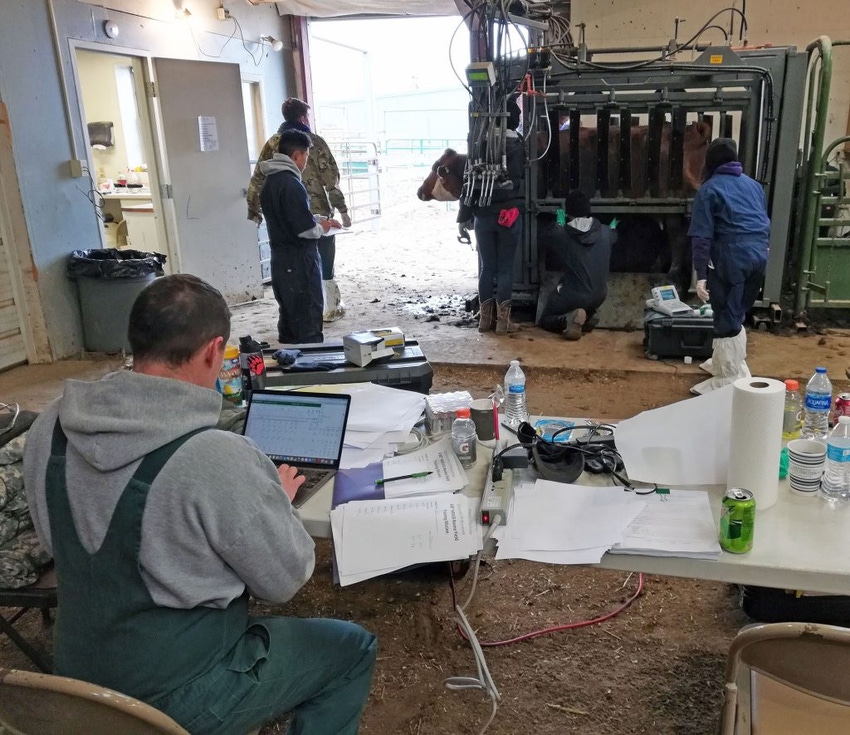Goal is to identify traits that make some cattle more prone to parasitism, and then select against those traits.
August 31, 2020

Two cows on the same University of Wyoming McGuire Ranch pasture northeast of Laramie, Wyo., near Sybille Canyon: One cow has 383 horn flies sucking her blood while the other cow has four.
Why that remarkable difference?
Craig Calkins, a veterinarian turned Army major and now a doctoral student at the University of Wyoming, is helping extension range specialist Derek Scasta unravel the mystery of a pestilence that costs the livestock industry billions of dollars in losses, the university said in an announcement.
Calkins is eyeing whether shorter blood-clotting times of individual animals clog a fly’s attempts, whether a thicker hide frustrates flies and if elevation and environmental conditions — such as colder and wetter areas — affect fly parasitism.
Considered a filth fly, horn flies (Haematobia irritans) feast on a cow’s blood, leave to lay their eggs in manure and then fly back to their bovine buffet, the university said. Eggs hatch after about two weeks, and a new generation begins.
The flies pierce the hide and inject an anticoagulant to help free the flow of blood. Cattle swing their heads, slap their tails and twitch their skin in attempts to stop the biting.
“Seeing an animal with horn flies is a really discouraging situation when you think about that animal,” Scasta said. “Cattle producers suffer production losses because the animal is losing blood, but also because of these annoyance avoidance behaviors. Every time that animal picks its head up and swings, it’s not taking a bite of grass, so grazing time decreases.”
He said other researchers have found such cows produce less milk, which lowers weaning weights. The biting also slows growth rates of younger animals, such as calves or yearlings.
Some animals will be bothered more than others in any group.
“They may all look similar as far as you and I can tell, but there will be some cows infested more than others,” he said. “We’re trying to identify the traits those individual animals have that make them more or less susceptible to parasitism.”
Calkins’ study began with help from the military. The 438th Medical Detachment (Veterinary Service Support) from Ft. Carson, Colo., helped draw blood from University of Wyoming cattle, and Calkins analyzed blood-clotting times. Hide thickness in three different areas was measured using ultrasound.
“We were kind of surprised how fast some of the cows’ blood coagulated,” said Calkins, a graduate of Chadron State College who joined the Army in 2012 as a veterinarian. “Sometimes, it would be clotted in the tube before we could even get to the machine to run it.”
Army veterinarians have to return to school and specialize to continue in the service and have several options, the university said. Calkins chose public health, and the program in rangeland ecology and watershed management at the University of Wyoming returned him to his home state.
Cattle studied include those in the Bighorn Mountains and lower-altitude herds at the James C. Hageman Sustainable Agriculture Research & Extension Center near Lingle, Wyo. Other cattle are near Cheyenne, Cody and on the McGuire Ranch.
Calkins’ study requires documenting the extent of horn fly parasitism on cattle. He noted that trends across the state show decreasing horn fly parasitism at higher elevations.
“This is related to colder temperatures as elevation increases,” he said.
Full-frame, high-resolution photos of individual cows, taken just after sunup, are analyzed on a computer, and the numbers of horn flies are counted by rangeland ecology and watershed management undergraduate Cora Knowles, of Santa Maria, Cal.
“The sun illuminates the whole side of the cow, so the flies are really easy to see,” Calkins says. “You’re counting all of the flies over the body. We stratify the head, side of the legs, the belly, brisket and tailhead.”
Horn flies are easy to spot.
“They are a different size and, for some reason, horn flies always eat with the head down so their wings are making a ‘V,’” he said. “Who knew?”
Only one side of a cow is counted. “So, realistically, whatever number we come up with is likely doubled,” Calkins said.
The highest fly count was 383, noted July 4 last year, and that was just one side, he said.
“The next were 319, 280, 229, 219, 205 and 190,” he added. “The lowest was four. So, what’s the difference between the cows on the top and the cows at the bottom? That’s what I’m trying to find out.”
The goal is to identify traits that make an animal more prone to parasitism, and then cull it from the herd.
“Potentially removing those outlier cows that you know are super-prone to parasitism could save producers a lot of money,” Calkins said.
Producers use various treatment options, Scasta explained, pointing to a feed-through product containing an insect growth regulator, spraying, ear tags that contain an insecticide and back rubbers that disperse a chemical.
Each has its limitations, including insects becoming resistant to insecticides or the need for retreatment.
The data from the study may help develop options that help producers save money, the university said.
“If we are going to have an integrated pest management approach, some of these other things will be really important so we can select for certain cows that are less susceptible,” Scasta concluded.
You May Also Like


.png?width=300&auto=webp&quality=80&disable=upscale)
